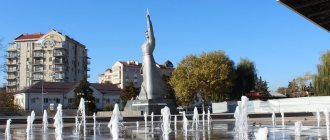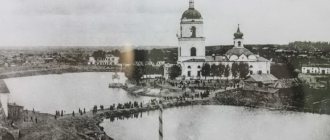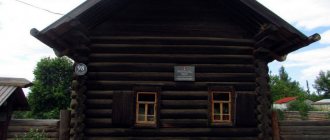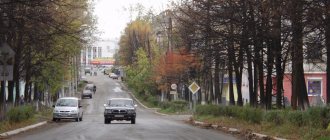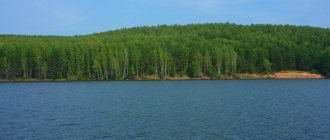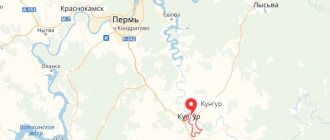Secrets of the name “Usman”
Vesti-Lipetsk found out where the beautiful name of the city came from
Probably every resident and guest of Usmani wondered: Where did such a strange and at the same time beautiful name of the city come from? This question is not easy to answer, since there are many versions. Some are legendary, others are speculative, and others are historically reliable.
Usmanka's unrequited love
Photo source: pinterest. ch
There is a legend that connects the appearance of the name of the area with the khan’s daughter Usmanka. According to it, on the site of the modern city, a Tatar tribe once lived, and its leader had a beautiful daughter, Usmanka. She fell in love with a Russian guy, but her father was against this relationship. Out of grief, Usmanka threw herself into the river. From there they began to call the river Usman, which allegedly means “beauty” from Tatar.
Having heard such a legend, the Decembrist poet Odoevsky wrote a poem comparing the Usman River with a wayward and flirtatious beauty.
However, according to historian Boris Knyazhinsky, the legend of the drowned girl, although beautiful, is hardly plausible. In the Turkic language, the word “Usman” has a different meaning than “beauty”.
It is possible that this toponym was based on the name of the Mongol-Tatar prince who once roamed here, since among the Turkic-speaking peoples the name Usman or Osman is still common.
Alternative versions
Usmanka River (photo source: yandex.ru)
Some scientists are inclined to consider “Usman” not a Turkic word, but an Iranian word “asman”, meaning stone. Local historian Vladimir Prokhorov suggests that the name of the area was brought here in the 10th century by the Slavs who moved to the Don region from the Chernigov land, where there was a river with the same name and a rocky bottom.
However, Prokhorov's version remains controversial in academic circles. The fact is that the word “asman” has many meanings and pronunciation options. One of the analogues of the word “asman” can be the Turkic word “usman” - “to grow”, “growing”, which could form the basis for the name of the river. Perhaps the name is related to the location of the river, which runs along the large Usman forest.
Usmansky pine forest (photo source: infourok.ru)
Also, some scientists have tried to connect Usman with the Finnish word “usma”, meaning fog. However, no one was able to prove this assumption.
Slavic origin
Slavic settlement (photo source: centr-intellect.ru)
According to another version, which is followed by most historians and scientists, the name of the area was given by Slavic tribes who lived in the 8th-10th centuries along the banks of Voronezh, Don and Matyra. As Voronezh historian Vladimir Zagorsky suggests, the river was originally called “Usmyn” or “Osmon”. In the explanatory dictionary V.I. Dahl comes across the Russian word “usma” - tanned leather. Some researchers believe that in this area, Slavic tribes hunted and tanned the skins of killed animals.
Content
- 1 Etymology
- 2 Physiographic characteristics 2.1 Time
- 2.2 Climate
- 6.1 Automotive
The mystery of the name "Usman"
Turning to the toponymic legends of the past allows us to look into the depths of bygone centuries, when the Novy Usman land was inhabited by Turkic-speaking nomadic tribes. These tribes gave names to many rivers in our region.
Toponymic legends are not an entertaining, but an educational genre of folklore. For a long time it was of interest only to historians and ethnographers, and only very recently folklorists also turned their attention to it.
When comparing folk and scientific etymology, it turns out that in most cases there is always a share of fiction. Here folk imagination manifests itself with particular force. In general, Voronezh toponymic legends are distinguished by the originality of their plot and composition, and the Mongol-Tatar cycle is of particular interest to us. I will cite two such legends - they can be called pure fiction.
“A long time ago, a khan lived in our region, and he had a very beautiful daughter named Usmanka. And she fell in love with a Russian guy. But her father was against this love, and the girl drowned in the river out of grief. The river got its name from this girl.” Another similar legend: “The daughter of the Mongol-Tatar khan Usmanka drowned in the river, and the river was named after her.”
Photo: Mikhail Nebolsin
Perhaps the name is related to the location of the river, which runs along the large Usman forest. From historical documents we clearly see that the Usman forest waged a centuries-long struggle with the steppe along the Usman River: either the steppe ran onto the right bank of the river, forming hollow places, or the forest spread across the river, to the left bank, deepening in large wedges to the east into the steppe expanses . This feature was historically reliably noted by I. S. Nikitin in his poem “Fist”:
...Long ago, in the harsh wilderness, the oak forest rustled here menacingly, spoke with the desert wind, and an eagle swam in the clouds...
Population[ | ]
| Population | ||||||||
| 1856[9] | 1897[9] | 1913[9] | 1926[9] | 1931[9] | 1939[10] | 1959[11] | 1967[9] | 1970[12] |
| 5500 | ↗10 000 | ↗12 700 | ↘7000 | ↗13 600 | ↘11 386 | ↗11 885 | ↗16 000 | ↗20 150 |
| 1979[13] | 1989[14] | 1992[9] | 2000[9] | 2001[9] | 2002[15] | 2003[9] | 2005[9] | 2006[9] |
| ↘20 118 | ↗20 878 | ↗21 000 | ↘20 800 | ↘20 600 | ↘20 133 | ↘20 100 | ↘19 600 | ↘19 500 |
| 2009[16] | 2010[17] | 2011[18] | 2012[19] | 2013[20] | 2014[21] | 2015[22] | 2016[23] | 2017[24] |
| ↘19 422 | ↘18 685 | ↘18 668 | ↗18 832 | ↗19 148 | ↗19 432 | ↗19 739 | ↗19 805 | ↗19 958 |
| 2018[25] | 2019[26] | 2020[2] | ||||||
| ↘19 956 | ↘19 653 | ↘19 625 | ||||||
As of January 1, 2022, in terms of population, the city was in 678th place out of 1,116[27]cities of the Russian Federation[28].
Where did the name Usman come from?
In 1645, the defensive fortress Usman was built on the site of the current city. It was built by governor S. M. Velyaminov. After 30 years, the fortifications fell into disrepair, but the danger from the south remained. Therefore, in 1684 they were restored. In addition, the city of Demshinsk was built next door.
Families of service people lived in the surrounding settlements - Streletskaya, Pushkarskaya and Cossackaya.
By the 1780s, the fortifications had fallen into disrepair again: all that remained was an earthen rampart and a shallow ditch.
Later, in 1779, Usman became a city - the center of the Usman district.
In the 1790s, a stone cathedral Church of the Epiphany was built on Bazarnaya Square. This was Usman's first brick building. Earlier, in 1778, the stone Pyatnitskaya Church was erected on this square, and in 1788 - the stone St. Nicholas Church.
No later than 1763, there was a wooden Kosmodamian church in Usman. In 1825 it burned down, and in 1828 they began to build a new one in the same place. But it was not possible to complete the work: when the building was built up to the dome, cracks appeared on it; I had to dismantle everything down to the foundation. New construction ended at the end of 1864.
During Soviet times, the Epiphany, Pyatnitskaya, St. Nicholas and Kosmodamianskaya churches were demolished. Of the church architecture in Usman, only the Church of the Assumption of the Blessed Virgin Mary remains.
Map
| Usman: maps |
Usman: photo from space (Google Maps) Usman: photo from space (Microsoft Virtual Earth)
| Usman. Nearest cities. Distances in km. on the map (in brackets along roads) + direction. Using the hyperlink in the distance , you can get the route (information courtesy of the AutoTransInfo website) | |||
| 1 | Upper Hawa (Voronezh region) | 26 (30) | SE |
| 2 | Ramon (Voronezh region) | 30 (128) | SW |
| 3 | Volya (Voronezh region) | 35 () | SW |
| 4 | Khlevnoe | 46 (84) | Z |
| 5 | Borinskoe | 51 () | NW |
| 6 | Mud | 51 (57) | WITH |
| 7 | Dobrinka | 51 (86) | IN |
| 8 | Novaya Usman (Voronezh region) | 51 (91) | SW |
| 9 | Panino (Voronezh region) | 53 (59) | SE |
| 10 | Voronezh | 56 (113) | SW |
| 11 | Lipetsk | 62 (90) | WITH |
| 12 | Semiluki | 63 (124) | SW |
| 13 | Zadonsk | 66 (190) | NW |
| 14 | Mordovo (Tambov region) | 70 (121) | IN |
| 15 | Kashirskoye (Voronezh region) | 71 (121) | YU |
| 16 | Latnaya (Voronezh region) | 72 (127) | SW |
| 17 | Petrovskoye (Tambov region) | 73 (89) | NE |
| 18 | Ertil | 76 (118) | IN |
| 19 | Anna (Voronezh region) | 78 (174) | SE |
| 20 | Khokholsky (Voronezh region) | 82 (157) | SW |
| 21 | Kolodezny (Voronezh region) | 83 (147) | YU |
| 22 | Novovoronezh | 88 (152) | SW |
| 23 | Kind | 90 () | WITH |
| 24 | Tokarevka (Tambov region) | 98 (155) | IN |
| 25 | Dolgorukovo | 98 (254) | Z |
| 26 | Terbuny | 99 (224) | Z |
| 27 | Davydovka (Voronezh region) | 101 (154) | YU |
| 28 | Dace | 103 (122) | NW |
| 29 | Zavoronezhskoe (Tambov region) | 107 (125) | NE |
| 30 | Michurinsk | 107 (127) | NE |
a brief description of
The city is located within the Oka-Don Plain, on the river. Usman (left tributary of the Voronezh River, Don basin), 75 km south of Lipetsk. Railway station. Road junction.
Territory (sq. km): 12
Information about the city of Usman on the Russian Wikipedia site
Historical sketch
Founded in 1645 “by order of the sovereign” by governor Stepan Velyaminov as a fort on the Belgorod defensive line. Name by river Usman (left tributary of Voronezh); hydronym from Old Iranian asman “stone”.
In 1652 it was subjected to a devastating raid by the Tatars.
And in 1708 it was assigned to the Azov province (from 1725 - Voronezh province), from 1719 to the Voronezh province. Since 1779, the district town of Usman of the Tambov governorship (since 1796 - Tambov province).
In 1856, in the district town of Usman, Tambov province, there were 5 churches, 600 houses, 90 shops.
At the end of the 19th - beginning of the 20th centuries. Usman is the center of grain trade (more than 1 million poods of grain were sent to Moscow and exported annually), the production of shag, and the sale of horses from local horse breeding.
Economy
Foundry equipment plant, tobacco factory, etc.
Usman is the center of an agricultural region (wheat and makhorka crops; meat and dairy farming).
Culture, science, education
Museum of Local Lore.
Museums, galleries, exhibition halls
Usman Regional Museum of Local Lore 399340, Lipetsk region, Usman district, Usman, st. Lenina, 35 Phone(s): (47472) 2-1572 2-1672
| Population by year (thousands of inhabitants) | |||||||
| 1856 | 5.5 | 1979 | 20.1 | 2006 | 19.5 | 2016 | 19.8 |
| 1897 | 10.0 | 1989 | 20.9 | 2007 | 19.4 | 2017 | 20.0 |
| 1913 | 12.7 | 1992 | 21 | 2008 | 19.4 | 2018 | 20.0 |
| 1926 | 7 | 1996 | 21.2 | 2010 | 19.4 | 2019 | 19.7 |
| 1931 | 13.6 | 1998 | 21.0 | 2011 | 18.7 | 2020 | 19.6 |
| 1939 | 11.4 | 2000 | 20.8 | 2012 | 18.8 | 2021 | 19.4 |
| 1959 | 11.9 | 2001 | 20.6 | 2013 | 19.1 | ||
| 1967 | 16 | 2003 | 20.1 | 2014 | 19.4 | ||
| 1970 | 20.2 | 2005 | 19.6 | 2015 | 19.7 | ||
Famous natives[ | ]
- Journalist, public figure, teacher, participant in the revolutionary populist movement Yu. A. Bunin
- N. A. Yakubovich - Russian military teacher, lieutenant general (1903).
- Hero of the Soviet Union Colonel General M. P. Konstantinov
- Twice Hero of Socialist Labor, physicist, Nobel Prize laureate academician N. G. Basov
- Writer V.V. Ogarkov
- Writer A. I. Ertel
- Hero of the Soviet Union, poet B. A. Kotov
- Doctor of Technical Sciences, scientific chemist F. M. Flavitsky
- Writer L. N. Zavadovsky
- Professor P. V. Nikolsky
- Doctor A.I. Zhuravlev
- Dermatologist Gubarev
- Local historian, historian, teacher D. V. Komyakov
- Pre-revolutionary photographs
Cultural heritage sites[ | ]
- Confectionery shop of merchant Popov (late 19th century)
- House of the doctor Filkenshtein (XIX century)
- The house of the merchant Fedotov, rented for a noble meeting (XIX century)
- Real school building (1912)
- Torgsin building
- Gymnasium building (1872)
- The house where the writer A. I. Ertel lived (1865)
- Manor house of merchant Budarin (XIX century)
- House and bakery of merchant Yakovlev
- The house from the balcony of which the chairman of the executive committee N. N. Ispolatov announced the transfer of power into the hands of the Soviets
- Cyril and Methodius School (1830)
- House of merchant Korostelev
- Residential 2-storey house
- The building of the city merchant estate (now the local history museum) (1808)
- Treasury Building (1837)
- The building of a shag factory (built by the merchant Fedotov, owned by Volodarsky) (1901)
- House of merchant Kalinin (XIX century)
- House of Academician Basov
- House of lawyer Novoselov (XIX century)
- House of the writer L. N. Zavadovsky (beginning of the 19th century)
- City Hall Building (1833)
- Church of the Holy Assumption (1907)
- Towers of the courtyard of the Usman Sophia Virgin. monastery (1806)
- Arrest House (1912)
Leaders of Usman[30][ | ]
City mayors
- 1823 - Karyakin Vasily Gavrilovich
- 1829 - Popov Vasily Afanasyevich
- 1837-1839 - Gosteev Andrey Il.
- 1840—1845 — Kuznetsov Pyotr Veniaminovich
- 1845-1846 — Fedotov Vasily Abramovich
- 1846-1848 - Rostovtsev Ivan Nikitich
- 1848 - Bogomolov Ivan Danilovich
- 1848 - Gosteev Andrey Il. (not approved)
- 1849-1851 - Kuznetsov Pyotr Veniaminovich
- 1852-1854 - Bogomolov Ivan Danilovich
- 1855-1857 - Karyakin Nikolai Vasilievich
- 1858-1860 - Sklyadnev Andrey Alekseevich
- 1860 - Ogarkov Nikolai Fedorovich (not approved).
- 1861-1867 - Sukochev Grigory Dmitrievich
- 1867-1869 — Smykov Nikolay Alekseevich
- 1869-1872 - Sukochev Grigory Dmitrievich
- 1872-1882 — Vinokurov Georgy Alekseevich
- 1882-1890 - Novoselov Nikolai Tikhonovich
- 1890—1894 — Vinokurov Georgy Alekseevich
- 1894 - Sukochev Alexander Grigorievich (not approved)
- 1895-1899 - Sidelnikov Alexey Nikitich
- 1899-1918 — Ogarkov Fedor Vasilievich
Chairmen of the Usman City Executive Committee
- 1927 - Evseev Danil Alekseevich
- 1930 - Dolgikh T. Ya.
- 1942 — Goloshchapov Vasily Vasilievich
- Kalganova Maria Petrovna
- until 1953 - Drachev Grigory Vasilievich
- 1953-1955 - Artamonov Sergey Vasilievich
- 1955-1957 - Georgy Ivanovich Panchenko
- 1957-1965 - Poryadin Mikhail Andreevich
- 1965-1967 - Chernyshev Mikhail Timofeevich
- 1967-1969 - Nikolai Ivanovich Vorobyov
- 1969-1983 - Boev Viktor Gavrilovich
- 1983-1985 - Borzunov Alexander Timofeevich
- 1985-1988 — Strakhov Valery Dmitrievich
- 1988-1991 - Batov Viktor Matveevich
Heads of the city administration (heads of the city)
(in 1994-2005, when the city administration was liquidated, the functions of heads of the city administration were performed by deputy heads of the district administration)
- 1991-1996 - Batov Viktor Matveevich
- 1996-1997 - Lomakin Nikolay Alexandrovich
- 1997-1998 - Nikolay Ivanovich Kutishchev
- 1998-2004 - Frolov Nikolay Vasilievich
- 2004-2005 — Sirotinkin Alexander Vasilievich
- 2005—2015 — Sirotinkin Alexander Vasilievich
- 2015—2019 — Bokarev Alexey Sergeevich
- from 2022 — Vasilchenko Denis Sergeevich
Chairmen of the city council of deputies
- 1990 - 1991 - Tolstykh Alexander Timofeevich
- 1991 - 1993 - Batov Viktor Matveevich
- 2005—2015 — Maly Sergey Savelievich
- 2015 - 2022 - Svetlana Vladimirovna Ternovykh
- from 2022 — Maly Sergey Savelievich


